Many developers first gain an interest in computers through playing computer games, but some games are more directly tied to programming because they teach specific languages or skills that programmers commonly use.
These 16 games span different programming topics, and they either actively teach specific skills or give developers opportunities to practice them in fun ways.
Games for Learning Programming
- CodeMonkey Jr.
- Clash of Code
- Flexbox Froggy
- CodeCombat
- Untrusted
- CheckiO
- Oh My Git!
- Vim Adventures
- CSS Diner
- Screeps
Programming Games for Learning How to Code
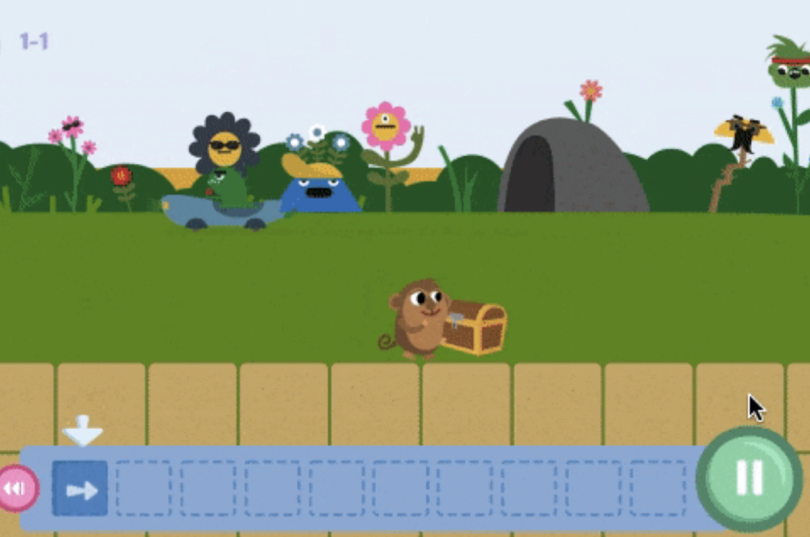
CodeMonkey Jr.
CodeMonkey is an online platform that teaches students how to write code in languages like Python and CoffeeScript. Its initial course CodeMonkey Jr. involves users working with graphical blocks that represent code snippets. This way, users can develop foundational coding skills without having to write actual code. More advanced courses cover topics like artificial intelligence, chatbots and data science. While CodeMonkey caters to K-8 students, it can be a helpful resource for those with little to no programming experience.
Cost: Free trial is available; paid plans start at $7 per month.

Clash of Code
CodinGame is a platform that trains users to program in more than 25 languages through individual and group games. Clash of Code is one of the platform’s competitive games, having multiple players try to solve a short coding problem. However, everyone wins in this competition — players share solutions at the end of the challenge, so other players can learn from them and improve their coding knowledge. As a result, players can constantly broaden their programming skills, whether they’re current or aspiring software developers.
Cost: Free plan offers limited access; paid plans start at $70 per month.

Flexbox Froggy
Flexbox Froggy eases users into writing CSS code by having them enter CSS code to guide frogs to the correct lily pads. The game contains a user-friendly interface for simplicity, so users can learn the basics of Flexbox properties and CSS code. However, the game progressively gets harder with each level until users have completed all 24 levels. The goal is to ensure users are more comfortable navigating Flexbox after the final challenge.
Cost: Free.
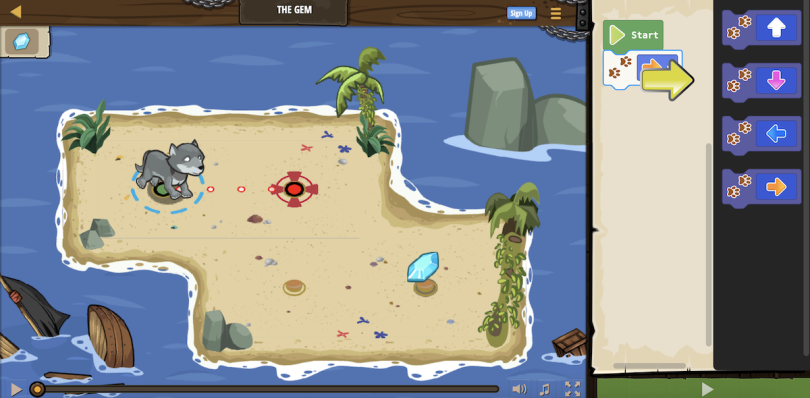
CodeCombat
CodeCombat is a platform that teaches text-based coding, giving users a realistic experience of working with popular languages like C++, JavaScript and Python. The game CodeCombat has players guide characters through different levels while learning about basic syntax, strings, loops, functions and more. Once players unlock advanced levels, they can explore more complex topics in game and web development.
Cost: Free plan for access to basic levels; premium plan starts at $14.99 per month for broader access.

Untrusted
Untrusted is an adventure game that helps users hone their JavaScript programming skills. Players must guide the main character, Dr. Eval, through various levels by solving JavaScript problems. The game is a more challenging exercise in problem-solving and JavaScript, so it’s best if players have some experience working with JavaScript beforehand.
Cost: Free.

CheckiO
CheckiO lets players solve challenges using either Python or TypeScript. In this strategy game, players make their way through different islands, progressing from easy levels to more difficult levels. Along the way, players may receive hints or access to other players’ solutions, so they can overcome any obstacles and further expand their coding knowledge. The game is then accessible to beginner and experienced programmers alike.
Cost: Free with an account.

Oh My Git!
Oh My Git! teaches developers how to use Git commands and manipulate files. Players can download the game on their Linux, Mac or Windows machines and progress through the levels to learn more complex Git techniques. The game provides visualizations of Git commands so developers can clearly understand the effects of their instructions on files. Players can test out all the commands they learn on real Git repositories within the game and practice interacting remotely with team members.
Cost: Free.
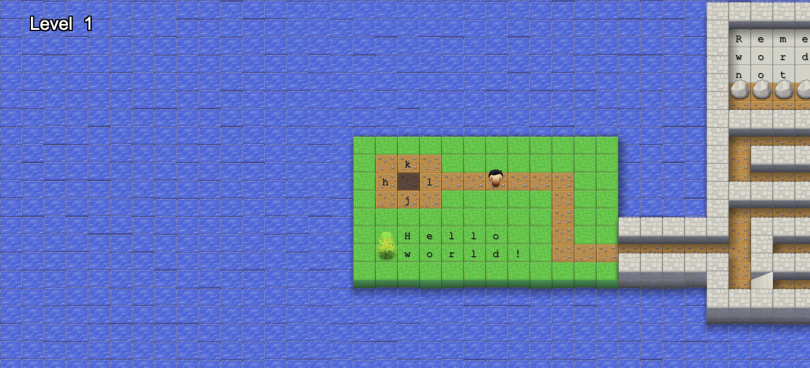
Vim Adventures
Vim Adventures offers an ingenious way to teach essential Vim commands to students. Actions that players take to navigate through the game and solve puzzles mirror the commands and keyboard shortcuts developers must learn to interact with Vim. The gameplay quickly makes those commands feel like second nature, and the game design makes for a fun and enjoyable experience.
Cost: Free demo level; $35 for six months’ access to the full version.
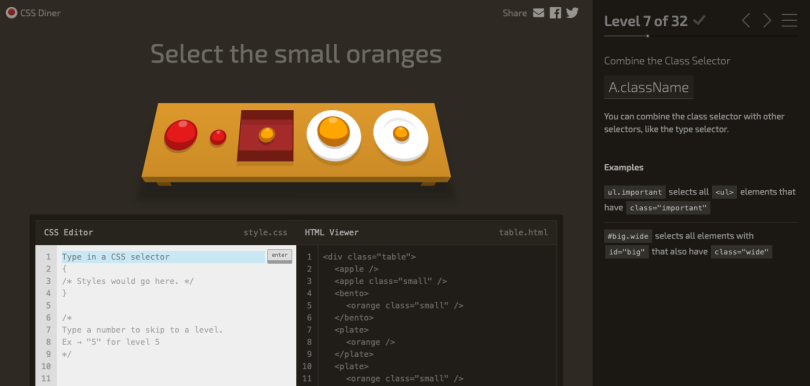
CSS Diner
CSS Diner attempts to teach developers the intricate rules of CSS selection through a game that imagines HTML elements as plates of food. An animated section at the top of the game displays increasingly intricate arrangements of food laid out on a table, and it’s accompanied by a simplified HTML section that represents the food arrangements in HTML format and an editable CSS section. Players are prompted to select certain food items from the table by writing the correct CSS code to select the particular food item.
Cost: Free.
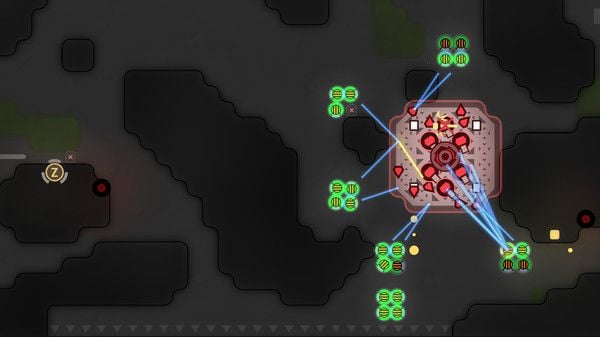
Screeps
Screeps combines JavaScript programming with multiplayer online gameplay to create self-sustaining colonies. Players interact with the game through an interface that closely resembles developer tools in browsers, complete with a console, scripts and error messages. Players can type their JavaScript code into the console to perform one-off actions and add code to script files that can be reused and looped. Controls on the side of the game allow players to configure settings (like speeding up time) to iterate through code more quickly. The game caters to developers who are comfortable writing in JavaScript but not yet JavaScript experts.
Cost: $14.99 on Steam.
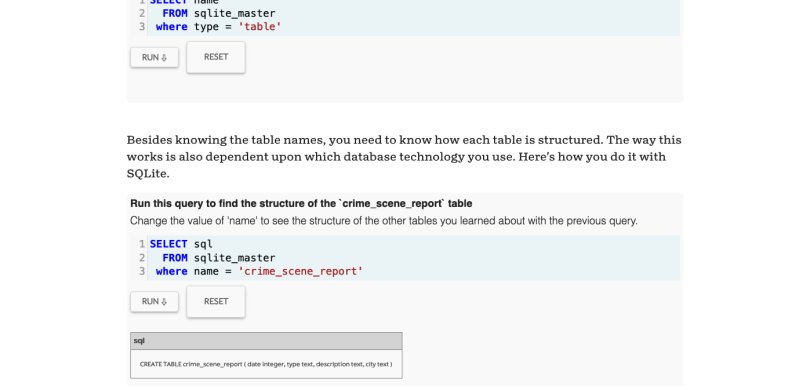
SQL Murder Mystery
This game has players execute SQL queries to get more information about the circumstances of a murder and find the murderer. SQL Murder Mystery does a good job teaching different ways of extracting data and metadata using queries, so players don’t have to be database experts to enjoy this game. The game interface is just an input box where players can write SQL queries following the SQLite syntax, hit the Run button and see the query results displayed just below. In cases where the results of a SQL query are too long, players must execute more precise queries to narrow down their search parameters.
Cost: Free.
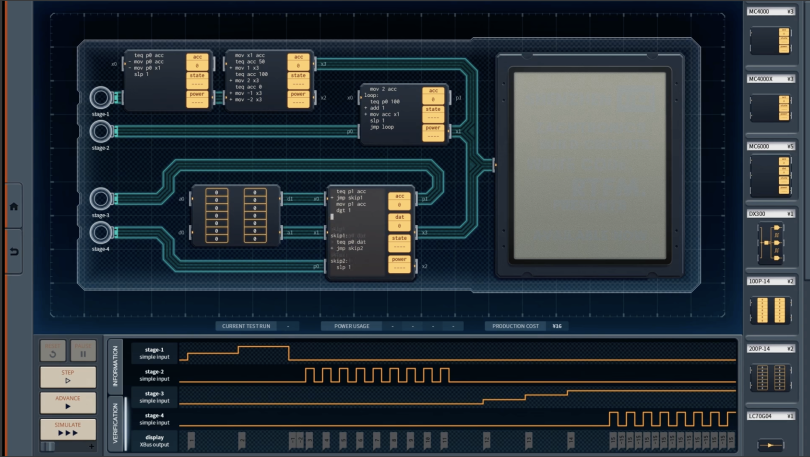
Shenzhen I/O
In Shenzhen I/O, the player takes on the role of a disaffected engineer who moves to Shenzhen, China, to build computer chips at the fictional Shenzhen Longteng Electronics company. Players are handed increasingly challenging circuits to design, beginning with an assignment to make lights flash in a distinct pattern. Side puzzles throughout the game make for fun additional challenges, and a throughline in the game’s plot hints at mysterious problems within the company that the player can explore. The game is great at helping developers visualize the interface between hardware and software and how computation occurs on a lower level.
Cost: $14.99 on Steam.

Human Resource Machine
In this game, players work at a giant, drab corporation that wants to use automation to speed up work and drive down costs. Players must “program” employee minions, who perform very dry assembly-line work, in such a way that they pick up the right items, arrange the items in the correct order and send the items off to their proper destinations. Instead of writing code, players program employees to work the assembly lines by using draggable commands that, fittingly, mimic assembly language.
Cost: $14.99 on Steam.

Robo Instructus
In this game, players write code to control a little robot that needs to move through a series of obstacles to reach the end of each level. The game starts easy, giving players a few commands to orient the robot within the game and move it around. Each level unlocks new functions that players can use, making the code they write and the actions the robot can take more sophisticated. Other concepts are slowly introduced, like loops and conditional statements, and even the idea of scope within programs. Players can also check how efficiently their code solves the solution on each level.
Cost: $11.99 on Steam.

While True: learn()
The game while True: learn() takes players through many different types of machine learning techniques, introducing new techniques for players to use in the order that they were invented in the real world. In the game’s storyline, the player is an engineer who lives with his cat and trains machine learning models for work. The engineer soon realizes that his cat is a machine learning genius — if only he could understand what his cat is trying to tell him. With that, the game kicks off by having the player build a cat-to-human translation model.
Cost: $12.99 on Steam.
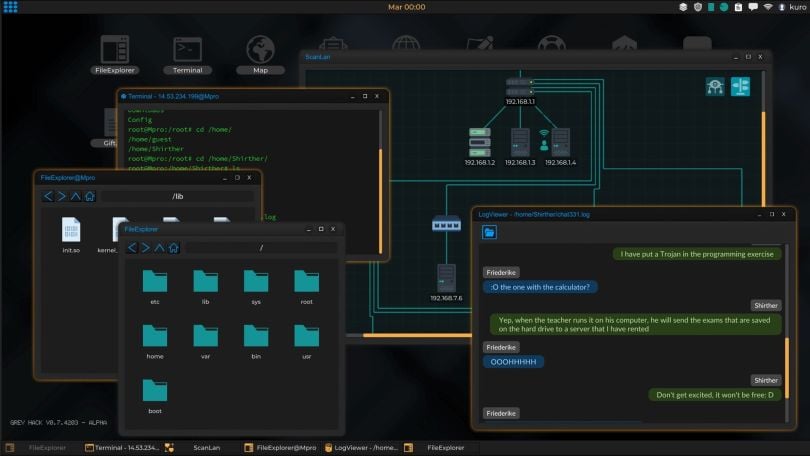
Grey Hack
Grey Hack is designed to feel like a hacking simulation, giving players free rein to do what they want within the boundaries of the game. Players are given missions and largely left to figure out how to complete them on their own by exploring the world of the game, reading the in-game manual and mixing technical exploits with social engineering to get their objective. It’s possible to interact with other players within the game by attempting to exploit them or defending yourself from their exploits.
Cost: $19.99 on Steam.




